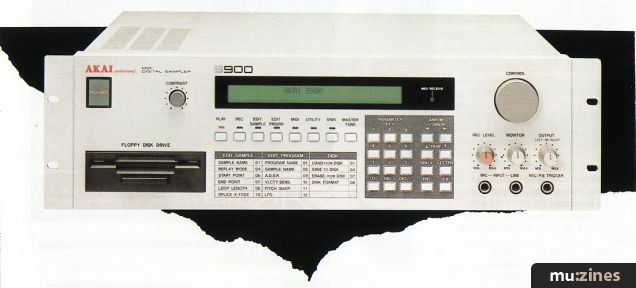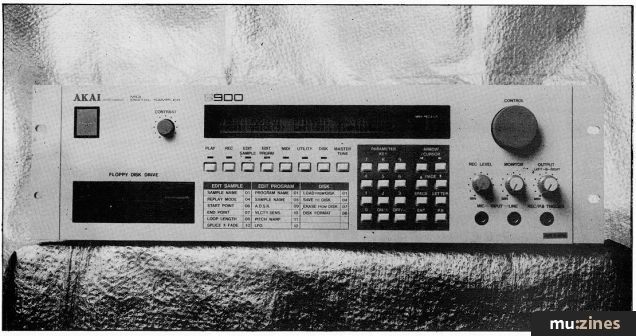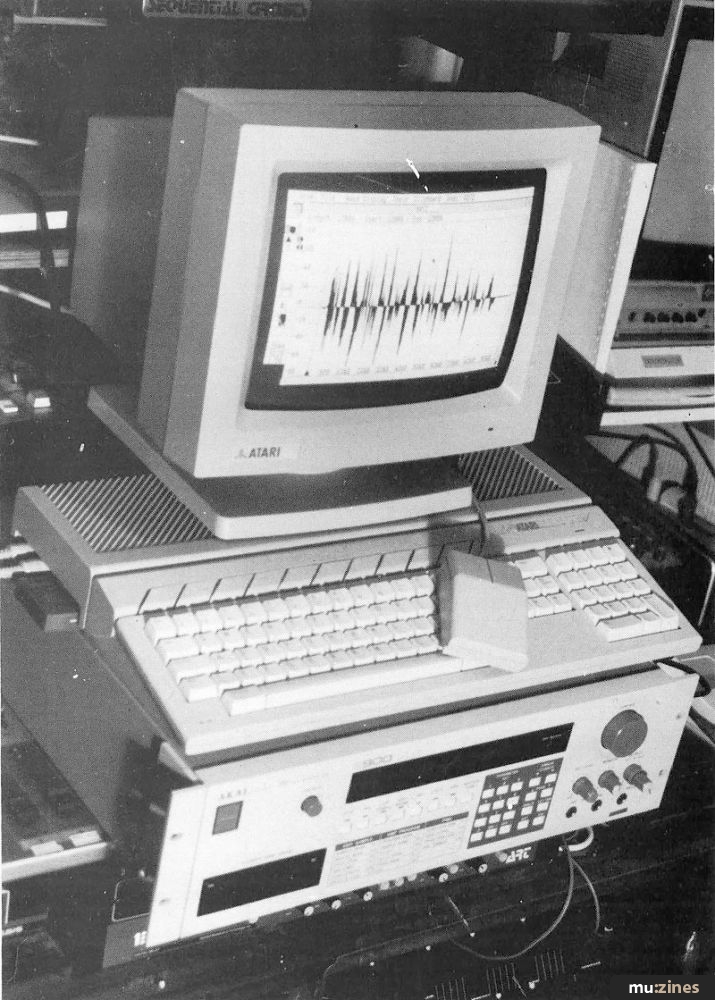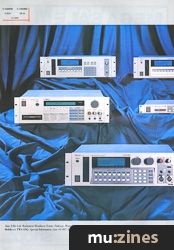Magazine Archive
Home -> Magazines -> Issues -> Articles in this issue -> View
Akai S950 Digital Sampler | |
Article from Music Technology, January 1989 | |
As musicians demand ever more from their samplers, Akai replace the studio-standard S900 with an enhanced machine. Vic Lennard samples the march of progress.
After three years as an industry standard, the time has come for the S900 to make way for its successor. Welcome the S950 with time stretching facilities, expandable memory and hard disk interface.

WITHOUT A SHADOW of a doubt, the Akai S900 has left a lasting impression on the music industry, and many people still rate its sonic quality as being the best available from a 12bit sampler. With visual editors to make the machine easier to use available from the likes of Steinberg, Drumware and Digidesign, the S900 has become the standard against which other samplers of a similar nature were measured. Then, lo and behold, exit S900, S700 et al, and voila - enter the Akai S950.
Ringing the Changes
FROM A VISUAL point of view, little has changed on the S950 from the S900. The S950 now sports blue and grey keypad buttons and restyled rotary knobs (the same as on the S1000), and the 3.5" disk drive has undergone some subtle changes in external appearance.
On powering up the S950, you are greeted with a message proclaiming the machine's identity and announcing the availability of 512 Kwords of memory space. The first major improvement over the S900 is that the new sampler's memory is expandable from a standard 512 Kwords (750 Kbytes) up to 536 Kwords (2.25 Mbytes) by removing the bottom panel and plugging in one or two EXM006s, which each consist of 6 RAM chips. With this expansion in mind, the maximum number of samples in memory has been increased from 32 to 99 and the keygroups from 64 to 198. The feel of the keypad is lighter and, unless my eyes deceive me, the backlit screen is brighter than the old 900's.
Another positive development is that, whereas the S900's software updates had to be booted off disk, both of these upgrades are included in the 950's ROM and so exist in memory as soon as the sampler is turned on.
The new disk drive is capable of reading from and writing to either double or quad density (HD) disks and is far quieter in use than the S900's. Although a 12-bit machine itself, the S950 will also read 16-bit S1000 disks, presumably ignoring the last 4 bits of information (few people realised that the S900 was able to read samples of between 8 and 16 bits, as long as it received correct instructions). Having tried this out, I can report that S1000 samples sound almost as good as they do on the parent machine.
The sampling rate has now been increased to a maximum of 48kHz in keeping with the domestic R-DAT rate and gives a bandwidth of 19.2kHz. This indicates that the design of the input filters has been improved and it is these which usually ensure that any audio input above half the sampling rate is sharply rolled off to avoid what is termed "aliasing" - the echoing of frequencies in the upper half of the sampling rate into the lower half.
The optional Atari hard disk/CD/DAT interface board (IB105) permits sampling from CDROM and R-DAT directly. In these cases the recording rates will need to be set at either 32, 44.1 or 48kHz, depending on the source, and as the board has both fibre optic and phono (SPdif) inputs, both of these are offered as options under the recording function. A minor point, but the S950 display really should show 44.1kHz as the CD frequency and not 44kHz as it does.
The S950 allows you to continue using playback while loading in new programs/samples, as long as the required samples for the program playing are still onboard, which is especially useful when memory expansion boards have been fitted, S900 owners will be pleased to learn that the S950 will accept S900 disks. Loading a full S900 disk takes about 40 seconds.
The S900 had the ability to velocity-crossfade samples, which allowed for the mixing together of two sounds with the balance of the mix dependent on the key velocity. This feature can be particularly useful when retreating sounds which vary timbrally with playing velocity. For example, a Fender Rhodes has a distinctly different timbre when played softly than when hammered, and the sound gradually moves between these two extremes in response to playing technique.
This facility tended to be impractical to use on the S900 due to its relatively limited memory size, as sounds treated in this manner require two samples to be taken for loud and soft allocation. Unfortunately, despite the expandable memory available on the S950, velocity crossfading has not been implemented. For some reason the manual still carries the crossfade explanation diagram on page 12, yet states categorically on page 21 that "There is no velocity X fade function in the S950". Worse still, the spec at the back lists "Velocity crossfade" as an edit possibility.

Time Sttrretchingg
AND NOW. LADIES and gentlemen, the moment you've all been waiting for. Time stretching allows the length of sample to be changed without altering its pitch. The original sample length is taken to be 100% and this can be altered proportionately - reasonably enough, 50% will halve the length while 300% will triple it. As far as I can make out, the S950's time stretching uses digital harmonising. There are only two alterable parameters: D-time is the delay factor, while mono/poly affects the character of the stretched sample. If a sample of constant pitch is being used, Auto D will attempt so calculate the best D-time. Although high values of D-time cause echoes and small ones gives a ringmodulator type of effect, uses such as varispeeding a master, transposing a piece of music while leaving one of the original phrases unchanged, or just getting a loop to the right length while leaving the pitch unchanged, can give good results.
Unfortunately, time stretching can cause problems with looped samples if a perfectly looped sample is time stretched, in loses that loop and has to be auto looped again - but all too frequently the S950 isn't able to find new auto loop points.
On the other hand, you can take a sample which has proved difficult to loop, stretch it to 200% and find that the autolooping takes to it like a duck to water. Oh well, you win some, you lose some.
From the point of view of sound quality, the affected sample is of a practically identical standard to the original, especially if only small percentage changes have been used.
The numbers freaks among you can delight in the maths involved in keeping a sample's length the same at a key change. If the key change is upwards, multiply 1.0595 by itself for as many semitone as the transposition and then multiply by 100. So for an increase of three semitones (a minor third), this gives 1.0595 X 1.0595 X 1.0595 X 100, which equals 119% to the nearest percent Then transpose this altered sample up three semitones and the result should be a correctly pitched tone of the right length. If the key change is downwards, then follow the same procedure, but divide into 100. So for a decrease of three semitones, the required factor will be 100 (1.0595 X 1.0595 X 1.05951 which gives 84% followed by a transpose downwards of three semitones. The ability to do this is unavailable on any other piece of gear at the price level of the S950.

Notching Disks
TIME TO START a row. The ability of the S950 and S1000 to load both double density and high density disks leads me to an interesting observation. If you've been buying double sided/double density disks for any period of time, you'll probably be aware that disks manufactured by name companies but not bearing a brand name can be bought for around a quid a time. Meanwhile, high density (HD) disks cost at least £2.50 - nearer £5 if purchased individually from a shop.
But there's an alternative. The only visible difference between the two types of disk is an extra cut out opposite the write protection cut-oat. If you make this extra hole in a DSDD disk it will work as a high-density disk. Obviously you ran the risk of losing your data on a disk that isn't up to scratch. The risk is yours (and mine) but I can point out that I know Casio FZ1 owners have been using this trick without trouble for some time now. If you're in doubt, you can always use such disks as a cheap way of backing up your samples. There, I've said it.
Problems
ROLAND'S S550 ADDED a new dimension to the 12-bit sampler by going for 16 voices which are dynamically allocated to eight polyphonic audio outputs. However, on the S950 Akai have retained the eight voices and monophonic audio outs of the S900. While the 950 does have left and right audio outs, these cannot be treated as extra individual outs - instead, voices 1-4 are allocated to the left output and 5-8 to the right output.
In their September press release, Akai announced that "the S950's disk drive can be activated via MIDI for programme selection". Apparently this should have read hard disk drive; a slip of the pen, perhaps, but for a while some retailers (and magazines other than MT) were taking the Akai line - and why shouldn't they? You have been warned.
Akai's press release also spoke of double speed MIDI being employed to increase the speed of sample-dumping via the five-pin DIN - a tedious process at the best of times. This facility may well exist, but, an the time of writing, no-one at Akai appears to know how it is implemented, as they haven't received the SysEx information from Japan.
Another casualty of the upgrade from S900 to S950 is the ASK90 audio-to-drum-trigger interface, which sat comfortably in the rear panel of the S900. This is incompatible with the S950; instead, you have to use Akai's new ME35T trigger-to-MIDI interface (which costs about £250). Now, as far as I can see, the only reason for this is that the rear mounting for the ASK90 is now required for the hard disk interface and I assume that to re-cut the metalwork would have been expensive. Some people complain of a delay when using the ASK90, but after 18 months of studio use, not one drummer has ever complained about mine. Effectively, anyone wishing to replace their S900 with an S950 will have to replace their ASK90 with an ME35T - shame.
One final moan - the S950's manual is basically a re-write of the original S900 manual. The trouble here in that it was never a definitive work and hasn't improved with its adaptation for the S950. It seems to be an opportunity Akai have missed to correct a shortcoming of an earlier machine.
Verdict
FOR THE FIRST-TIME buyer the S950 is an attractive proposition: a clean-sounding 12 bit machine with provision for memory expansion up to 2.25Mb, an interface for hard-disk storage of samples, and the ability to draw on the S900's comprehensive sample library (with S900 samples actually sounding better on the 950) as well as the growing library of samples available for the S1000.
Existing S900 owners may lament the passing of velocity-switching on the new sampler, and resent having to trade in their ASK90 for an ME35T, but, on the other hand, the S950 currently represents the cheapest way of getting into time-stretching and all the musical avenues which this feature opens up.
The S950 may not represent as much of an advance on the S900 as some people might have wished, but it certainly represents an attractive proposition to anyone serious about their sampling.
Prices S950, £1399; EXM006 expansion boards, £249;
IB105 board, £99. All prices include VAT.
(Contact Details)
Also featuring gear in this article
Featuring related gear
Akai S900 MIDI Digital Sampler
(IT Jul 86)
Akai S900 Revisited
(SOS Oct 87)
Akai S900 Sampler - SamplerCheck
(IM Jul 86)
Akai S900 Sampler
(EMM Jul 86)
Bits & Pieces - How To Upgrade Your Akai S900
(SOS Dec 88)
Eat your heart out PPG! - Akai S900 Sampler
(SOS Jul 86)
Getting The Most From... Mono Mode (Part 3)
(EMM Oct 86)
Sampling An Akai - Akai S900 Sampler
(HSR Sep 86)
Browse category: Sampler > Akai
Publisher: Music Technology - Music Maker Publications (UK), Future Publishing.
The current copyright owner/s of this content may differ from the originally published copyright notice.
More details on copyright ownership...
Review by Vic Lennard
Previous article in this issue:
Next article in this issue:
Help Support The Things You Love
mu:zines is the result of thousands of hours of effort, and will require many thousands more going forward to reach our goals of getting all this content online.
If you value this resource, you can support this project - it really helps!
Donations for May 2024
Issues donated this month: 0
New issues that have been donated or scanned for us this month.
Funds donated this month: £0.00
All donations and support are gratefully appreciated - thank you.
Magazines Needed - Can You Help?
Do you have any of these magazine issues?
If so, and you can donate, lend or scan them to help complete our archive, please get in touch via the Contribute page - thanks!


















